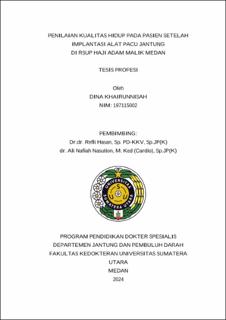| dc.description.abstract | Background: More than 500,000 permanent cardiac pacemaker implantations are performed worldwide each year. These devices send electrical impulses to the heart muscle to correct heart rhythm disturbances, which can arise from disruptions in the formation or delivery of the heart's electrical impulses. Assessing the patient's quality of life after a permanent cardiac pacemaker implantation is crucial for predicting the therapy's effectiveness and success. Moreover, such assessments can evaluate clinical factors and the cost-effectiveness of this health technology.
Objective: This study aims to assess the quality of life of patients after pacemaker implantation using the SF-36 questionnaire
Methods: A cross-sectional study conducted from January 2021 to July 2023 on 60 outpatients with a minimum duration of APJP implantation of 6 months in the cardiology department of H. Adam Malik Hospital Medan. Assessment of patient quality of life based on the SF-36 questionnaire.
Results: There were 60 patients included in this study. Majority of patients were male (56.7%) with an average age of 67.98 ± 10.95 years old and most patients had comorbidities (81.7%). The majority of patients (93.3%) had a single-chamber permanent pacemaker implanted, with 68.3% of these devices’ ventricular leads positioned in the non-apical segment of the heart. After assessing the quality of life, we found results where there’s a relationship between age, gender, and PPM lead locations with nearly all SF-36 domains (p<0.05). Additionally, there was a significant association between comorbidities and SF-36 scores, including physical function, role limitations due to physical health problems, and role limitations due to emotional health (p<0.05). There was a significant association between ejection fraction and SF-36 scores, including physical function, role limitations due to physical health problems, vitality, social function, bodily pain and general health. However, no relationship was found between body mass index and PPM implantation duration with SF-36 scores (p>0.05).
Conclusion: We identified a relationship between age, gender, comorbidities, PPM lead location, and left ventricular ejection fraction with the quality of life of patients following PPM implantation | en_US |


